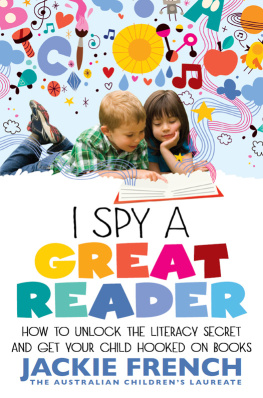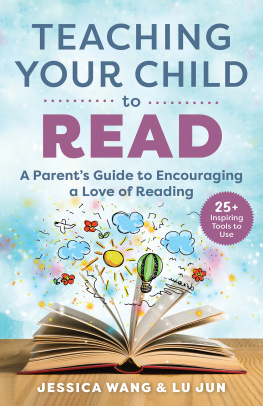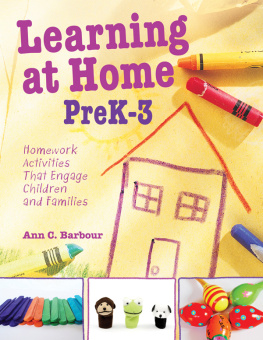Raising a Reader
Simple and Fun Activities for
Parents to Foster Reading Success
Bonnie D. Schwartz

Published in the United States of America
by ScarecrowEducation
An imprint of The Rowman & Littlefield Publishing Group, Inc.
4501 Forbes Boulevard, Suite 200, Lanham, Maryland 20706
www.scarecroweducation.com
PO Box 317
Oxford
OX2 9RU, UK
Copyright 2003 by Bonnie D. Schwartz
All rights reserved. No part of this publication may be reproduced, stored in a retrieval system, or transmitted in any form or by any means, electronic, mechanical, photocopying, recording, or otherwise, without the prior permission of the publisher.
British Library Cataloguing in Publication Information Available
Library of Congress Cataloging-in-Publication Data
Schwartz, Bonnie D.
Raising a reader : simple and fun activities for parents to foster reading success / Bonnie D. Schwartz.
p. cm.
Includes bibliographical references.
ISBN 1-57886-051-2 (pbk. : alk. paper) ISBN 978-1-57886-051-7
1. Reading (Early childhood) 2. ReadingParent participation. I. Title.
LB 1139.5.R43 S37 2003
372.4dc21
2003008376
 The paper used in this publication meets the minimum requirements of American National Standard for Information SciencesPermanence of Paper for Printed Library Materials, ANSI/NISO Z39.48-1992.
The paper used in this publication meets the minimum requirements of American National Standard for Information SciencesPermanence of Paper for Printed Library Materials, ANSI/NISO Z39.48-1992.
Manufactured in the United States of America.
Acknowledgments
This book is a culmination of many years as a teacher and learner. I am grateful to my mother, Dorothy Ann Schwartz, who was such an excellent and patient mother and teacher. Many of the ideas for songs and activities in this book were inspired by memories of my early years with my mother. Her oral stories, fairy tales, songs, and poems encouraged me to be a reader. Parents who share the love of music and reading are wonderful gifts to their children.
I am also grateful to my daughter, Jessica Lynn Mikes, who has been a willing guinea pig her entire life. Every idea or strategy I was exposed to was practiced on her. We waded through piles of books, sang a few million songs, played the games presented in this book (and more), and made a lot of road trips! I am proud to say that she has become a wonderful lifelong reader and learner, and I am delighted that she is studying to be an English teacher.
To every student I have ever had the pleasure of teaching, from preschool to high school, thank you for teaching me. To every teacher I have had the privilege of working with and learning fromfrom kindergarten teachers to current professorsI am eternally indebted. I am amazed at the vast knowledge that we can find in these dedicated professionals. There is no greater occupation. Where else can you read, play, sing, hang out with kids, and learnand get paid?
This book would never have been finished without the help of my great friend and proofreader, Mike Houck. Thank you for asking me if I worked on the book almost every day during the last month of writing. The constant encouragement was ego-boosting. I especially appreciate the painstaking efforts to read every word for content, agreement, and punctuation. No one could be a better friend and supporter. Mike also introduced me to his sister-in-law, Mari Houck, who did some of the proofing. It was the most comprehensive, detail-oriented proofreading I have ever experienced. Mari is talented! Thank you.
I would also like to thank Dr. Robert Brown, one of the outstanding professors at the University of St. Thomas. Dr. Brown introduced me to the editorial staff at ScarecrowEducation. That introduction was the beginning of my journey into the world of writing.
Finally, I would like to express my gratitude to all teachers devoted to the teaching of reading who have taken their time to share their research and best practices with the rest of the world. Their work has been an inspiration to me, as well as a resource for inspiring ideas.
Introduction
Children who are read to from an early age are more successful at learning to read.
W. Teale
Recent research into human brain development is proving that parents truly are their childrens first teachers. What parents do, or dont do, has a lasting impact on their childs reading skill and literacy. For example, there is considerable evidence of a relationship between reading regularly to a child and that childs later reading achievement.
National Research Council
There have been so many discussions and theories about reading and how children learn to read that it all can be very confusing. There are some simple research- and practice-proven approaches that a parent can do to promote literacy in the home and encourage children to explore the great adventures to be found in books. The first step in fostering literacy and good reading strategies in the home is to learn a little bit about how language is acquired and how this affects the development of reading. The first two chapters of this book focus on building some backround knowledge and savvy vocabulary so parents can successfully fulfill their role as their childs first and most critical reading teacher.
After building a knowledge base, it is important to become equipped with some tools and strategies. activities, materials, and resources to share with your child and guide him or her along the path of learning. It is important to share experiences and cultivate enthusiasm about all the components that join together to create the world of a reader. You are the mentor who will lead your new reader to a whole new world of sounds, rhythms, and words. As your child develops and grows as a reader, you can use the included comprehension techniques and strategies to help him or her achieve maximum understanding of the story and its meaning.
An important part of learning is assessment. How do I know if what I am doing is working effectively? expose you to user-friendly tools and checklists to monitor your childs progress. These tools can help identify areas of strength and also highlight areas to focus on to insure continued growth.
You have made an important and life-changing decision for your child. Your effort and enthusiasm in raising your reader will have unlimited benefits as your child grows and learns. Recognizing the important role reading plays in our lives and in the whole world is the first step. Your commitment will provide the best possible example for your child.
CHAPTER 1
The Basics
You are about to embark on a magical journey that will take you places you have never dreamed that you would or could ever go. You are a parent. You have decided to become the mentor, teacher, advisor, protector, and for at least the first few years, the center of your childs world. A major part of this journey will be guiding your child along the path to lifelong reading. Empowering your child with this precious gift will provide him or her with the key to unlocking adventures, mysteries, and a myriad of knowledge in the real world and within his or her imagination. With such a task at hand, how do you begin?
The first step is understanding what reading is and how reading is learned. Any dictionary will tell you that reading is the ability to examine and grasp the meaning of written or printed characters, words, or sentences. It seems pretty simple, doesnt it? The extremely complex process of developing into a reader is often taken for granted.
Reading is a meaning-making process. While your eyes scan the page, your brain is making lots of connections. Your optic nerve is sending visual messages to your brain. Your brain is decoding the letter symbols that make up the words by accessing the phonemic knowledge you have stored. It blends the letters into words and creates sentences. Meanwhile, your long- and short-term memory activates, seeking to make connections between the information on the page and what you have learned in your life. Simultaneously, your brain is asking questions about what you are reading and making predictions about what may happen next.
Next page








 The paper used in this publication meets the minimum requirements of American National Standard for Information SciencesPermanence of Paper for Printed Library Materials, ANSI/NISO Z39.48-1992.
The paper used in this publication meets the minimum requirements of American National Standard for Information SciencesPermanence of Paper for Printed Library Materials, ANSI/NISO Z39.48-1992.